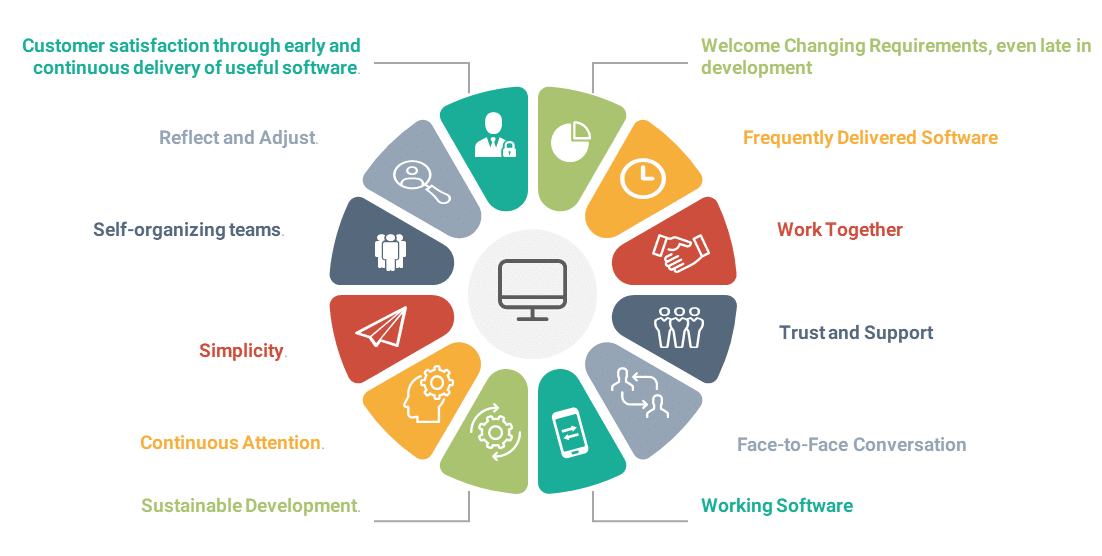|
Getting your Trinity Audio player ready...
|
Are you planning to deal with agile product engineering for your business growth? What will be the right approach to succeed in the market?
According to recent trends, the top priority of agile product engineering is reducing time to market, being cost-effective, enhancing customer satisfaction, and improving product quality. But do you have the insights to make an investment in this model?
Here, we will discuss in depth the principles, goals, benefits, and much more about this methodology.
What is agile product engineering?
It emphasizes product development while focusing on continuous growth, flexibility, and speed. A cross-functional team ensures the delivery of products and features trending in the industry. The proper procedure will help to deliver value to the target audience and decide the journey of your business.
An experienced team will break the product development into small, easily managed sections. It is crucial to focus on collaboration and communication within the organization for smooth management. Luckily, companies have the option of using business text messaging solutions to keep things more simple and quick.
Here are some of the critical sections of product engineering:
- Gather Information: This stage involves understanding the needs and preferences of the target market or customers and defining the key features and functionality of the product.
- Designing: This stage involves creating a detailed product design, including its physical form, user interface, and functionality. It also deals with building prototypes to test and refine the design.
- Testing: This stage involves testing the product to ensure that it meets the desired performance, reliability, and quality standards and validating that it meets the needs of the target market or customers.
- Manufacturing and production: This stage involves setting up the production process and manufacturing the product at scale while ensuring it meets the desired quality and cost targets.
- Launch and Marketing: This stage involves introducing the product to the market, developing marketing and sales strategies, and monitoring its performance and customer feedback to improve and refine the product continuously.
What Are the Principles of Agile Product Engineering?
[Source: https://bit.ly/3NQjoO3]
Here is the lists of principles that all the developers or business owners should follow during the product engineering process. This ensures that your business follows business standards and meet the expectations of the consumers.
Let us look at them:
- The highest priority is to satisfy the customer through early and continuous delivery of valuable software.
- Emphasizing working software over documentation is the primary measure of progress.
- Welcoming changing requirements as Agile processes harness change for the customer’s competitive advantage.
- Encouraging collaboration between team members by ensuring that business people and developers must work together daily throughout the project.
- Fostering a culture of continuous improvement at regular intervals, the team reflects on how to become more effective, then tunes and adjusts its behavior accordingly.
- Delivering working software frequently, with a preference for shorter timescales.
- Building projects around motivated individuals provide them with the environment and support they need and trust them to do the job.
- Fostering face-to-face communication is the most efficient and effective method of conveying information to and within a development team is face-to-face conversation.
- Measuring progress primarily through working software is the primary measure of progress.
- Agile processes promote sustainable development. The sponsors, developers, and users should be able to maintain a constant pace indefinitely.
- Focusing on the amount of work not done and then making efforts to deliver the results within the deadline specified by the customers.
When Should you use the agile Approach in Product Engineering?
1. Require a flexible solution:
It is designed to adapt to the trending demands of the business. This is highly essential for where you have to deal with a wide range of audiences and evolve with time.
2. Complicated Requirements:
This process can be highly effective when you are dealing with complex requirements. It will break the process into smaller segments and complete it efficiently. This also helps to identify the issues faster and resolve them instantly.
3. Collaborations:
It will ensure smooth communication with the team members, developers, designers, stakeholders, and clients. Product engineering and design with agile will ensure that everyone works towards a single goal and that all the issues are addressed instantly.
4. Faster customer feedback:
This model encourages regularly checking the platform’s performance and gathering customer experience. A business owner can use this information to provide instant fixes and improvements in the platform for better customer solutions.
5. Limited resources:
It brings a flexible solution where changes can be quickly done throughout development. This becomes easier for the developers when the requirements are not fully provided or may need changes before the final stage.
6. Less Time-To-Market:
It has its own model and prototype that ensures quick delivery of projects and effortlessly meet the deadlines if your product engineering goals are to reach the audience at the earliest.
What are the Unique Strategies for Agile Product Engineering?
Agile product engineering is a flexible and iterative product development approach involving collaboration and communication between cross-functional teams. Here are some strategies for implementing agile product engineering:
- Have a clear vision: This is essential for guiding the development process and ensuring that all team members are aligned on the overall goals and objectives of the project. The product vision should be communicated clearly with all team members and revisited regularly to ensure that it remains relevant and achievable.
- Focus on customers to define requirements: Use customer data, experience, and more to understand their needs and goals. They can be used to determine product requirements and to guide the development process.
- Use Sprints: These are short, time-boxed periods during which the team focuses on completing specific tasks. Sprints typically last 1-4 weeks and are designed to help the team stay focused and ensure progress. At the end of each sprint, the team must review the progress made and adjust the development plan as necessary.
- Prioritize features and tasks: Agile product engineering prioritizes features and functions based on their importance and value to the end user. This can be done using various techniques, such as user surveys, stakeholder feedback, and data analysis. Prioritizing features and tasks can help the team focus on the most critical aspects of the product and ensure that the product meets the end user’s needs.
- Collaboration and communication: It emphasizes collaboration and communication between team members. Everyone must work closely, share ideas and feedback and collaborate on problem-solving. Regular meetings, such as daily stand-ups and sprint reviews, can help facilitate communication and ensure everyone is on the same page.
- Test and iterate: Agile product engineering involves frequent testing and iteration to ensure that the product meets the end user’s needs. Agile Testing should be done throughout the development process, and user feedback should be incorporated into the development plan. Iteration is essential for improving the product and ensuring it remains relevant and competitive.
What are the Benefits of Agile Product Engineering?
1. Increased flexibility:
This flexible approach to product development allows teams to respond quickly to changing requirements and market conditions. By working in sprints and focusing on the essential features, teams can adjust their plans and priorities as needed, ensuring that the product remains relevant and competitive.
2. Improved collaboration:
Agile product engineering emphasizes collaboration and communication between team members. It ensures that your team builds stronger relationships and creates a more cohesive development process as they are aware of every action in the project.
3. Faster time-to-market:
It will help teams deliver products faster by focusing on the essential features and completing development in short sprints. This allows teams to get user feedback early in the process, making adjustments and improving the product more accessible.
4. Higher quality products:
Agile methodology in product engineering emphasizes testing and iteration, ensuring that the product meets the end user’s needs and is free of bugs. By testing early and often, teams can catch issues before they become more serious, resulting in higher-quality products.
5. Improved customer satisfaction:
This focuses on the end user’s needs, ensuring that the product meets their expectations and delivers the right solution. It will increase customer satisfaction and loyalty, resulting in a better overall customer experience.
6. Better alignment with business goals:
Agile product engineering ensures that the development process is aligned with the overall goals and objectives of the business. By prioritizing features based on their importance and value, teams can ensure that the product meets the company’s needs and supports its long-term growth and success.
Summing it up!
Agile product engineering is a product development process that focuses on continuous growth, flexibility, and speed. The critical sections of product engineering include gathering information, designing, testing, manufacturing and production, and launch and marketing.
This approach is best suited for businesses requiring a flexible solution, collaborations, limited resources, or less time-to-market.
Implementing agile product engineering requires having a clear vision and focusing on customers to provide an effective solution in the market. The unique strategies for agile product engineering help to develop a culture of transparency, encouraging experimentation and promoting ownership among team members.
By following these strategies and principles, businesses can efficiently create and launch products that meet the needs and preferences of their target audience while remaining competitive in the market.

About Author
Harshal Shah - Founder & CEO of Elsner Technologies
Harshal is an accomplished leader with a vision for shaping the future of technology. His passion for innovation and commitment to delivering cutting-edge solutions has driven him to spearhead successful ventures. With a strong focus on growth and customer-centric strategies, Harshal continues to inspire and lead teams to achieve remarkable results.


